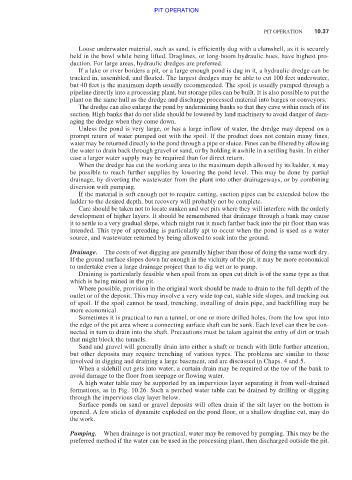Page 531 - Moving the Earth_ The Workbook of Excavation
P. 531
PIT OPERATION
PIT OPERATION 10.37
Loose underwater material, such as sand, is efficiently dug with a clamshell, as it is securely
held in the bowl while being lifted. Draglines, or long-boom hydraulic hoes, have highest pro-
duction. For large areas, hydraulic dredges are preferred.
If a lake or river borders a pit, or a large enough pond is dug in it, a hydraulic dredge can be
trucked in, assembled, and floated. The largest dredges may be able to cut 100 feet underwater,
but 40 feet is the maximum depth usually recommended. The spoil is usually pumped through a
pipeline directly into a processing plant, but storage piles can be built. It is also possible to put the
plant on the same hull as the dredge and discharge processed material into barges or conveyors.
The dredge can also enlarge the pond by undermining banks so that they cave within reach of its
suction. High banks that do not slide should be lowered by land machinery to avoid danger of dam-
aging the dredge when they come down.
Unless the pond is very large, or has a large inflow of water, the dredge may depend on a
prompt return of water pumped out with the spoil. If the product does not contain many fines,
water may be returned directly to the pond through a pipe or sluice. Fines can be filtered by allowing
the water to drain back through gravel or sand, or by holding it awhile in a settling basin. In either
case a larger water supply may be required than for direct return.
When the dredge has cut the working area to the maximum depth allowed by its ladder, it may
be possible to reach further supplies by lowering the pond level. This may be done by partial
drainage, by diverting the wastewater from the plant into other drainageways, or by combining
diversion with pumping.
If the material is soft enough not to require cutting, suction pipes can be extended below the
ladder to the desired depth, but recovery will probably not be complete.
Care should be taken not to locate sunken and wet pits where they will interfere with the orderly
development of higher layers. It should be remembered that drainage through a bank may cause
it to settle to a very gradual slope, which might run it much farther back into the pit floor than was
intended. This type of spreading is particularly apt to occur when the pond is used as a water
source, and wastewater returned by being allowed to soak into the ground.
Drainage. The costs of wet digging are generally higher than those of doing the same work dry.
If the ground surface slopes down far enough in the vicinity of the pit, it may be more economical
to undertake even a large drainage project than to dig wet or to pump.
Draining is particularly feasible when spoil from an open cut ditch is of the same type as that
which is being mined in the pit.
Where possible, provision in the original work should be made to drain to the full depth of the
outlet or of the deposit. This may involve a very wide top cut, stable side slopes, and trucking out
of spoil. If the spoil cannot be used, trenching, installing of drain pipe, and backfilling may be
more economical.
Sometimes it is practical to run a tunnel, or one or more drilled holes, from the low spot into
the edge of the pit area where a connecting surface shaft can be sunk. Each level can then be con-
nected in turn to drain into the shaft. Precautions must be taken against the entry of dirt or trash
that might block the tunnels.
Sand and gravel will generally drain into either a shaft or trench with little further attention,
but other deposits may require trenching of various types. The problems are similar to those
involved in digging and draining a large basement, and are discussed in Chaps. 4 and 5.
When a sidehill cut gets into water, a curtain drain may be required at the toe of the bank to
avoid damage to the floor from seepage or flowing water.
A high water table may be supported by an impervious layer separating it from well-drained
formations, as in Fig. 10.26. Such a perched water table can be drained by drilling or digging
through the impervious clay layer below.
Surface ponds on sand or gravel deposits will often drain if the silt layer on the bottom is
opened. A few sticks of dynamite exploded on the pond floor, or a shallow dragline cut, may do
the work.
Pumping. When drainage is not practical, water may be removed by pumping. This may be the
preferred method if the water can be used in the processing plant, then discharged outside the pit.

